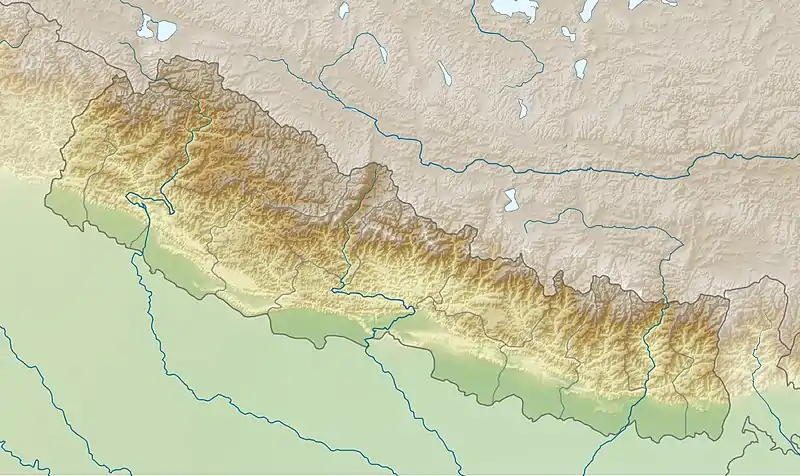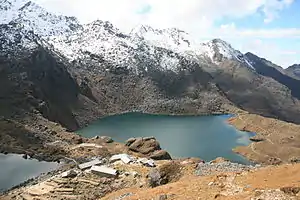Silu (song)
"Silu" (Devanagari: सिलु) is a traditional Nepalese song about a couple from Kathmandu who go on a pilgrimage to Silu and get separated.


The ballad in Nepal Bhasa dates from the early 19th century.[1][2]
Written by an unnamed composer, Silu is a popular seasonal song in Newar society. It is one of the six seasonal songs and is sung during the rainy season (August).[3]
Silu is what the Newars call Gosaikunda, a holy lake located to the north of Kathmandu.[4][5] Situated at an elevation of 4,380 m in the Himalaya, it is associated with the Hindu deity Lord Shiva. The lake is also held sacred by Buddhists who associate it with the Bodhisattva Avalokitesvara.[6]
Synopsis
The epic song is in the form of a dialogue between the husband and wife. When he announces his plan to visit Silu to take part in the ritual bathing festival, she expresses her desire to go with him. He tries to dissuade her by reminding her of the saying that a husband and wife going together is bad luck. But she insists, and he lets her come along.
When they reach Silu, the king sees her and sends soldiers to take her away and forcibly makes her his queen. The depressed husband leaves home and becomes an ascetic.
One day, the queen asks the king to assemble all the ascetics on the palace grounds to give them alms. The sadhus are gathered as per her wish, and when she spots her husband among them, she slips away with him disguised as a nun. The couple are thus reunited.[7]
Pilgrimage
Silu Wanegu, the pilgrimage to Silu to take a holy dip in the lake, is a long-standing tradition in Newar society. The trek is done in August, when a festival is held on the full moon day.
The pilgrimage has also been a subject of art since historical times.[6] Silu, a movie based on the ballad, was released in 1987.
Lyrics
The first few lines of the song appear below.
|
Nepal Bhasa
|
Translation
|
See also
References
- Lienhard, Siegfried (1992). Songs of Nepal: An Anthology of Nevar Folksongs and Hymns. New Delhi: Motilal Banarsidas. ISBN 81-208-0963-7. Page 80.
- Crawford, S. Cromwell (1982). The evolution of Hindu ethical ideals. Asian Studies Program, University of Hawaii. ISBN 9780824807825. Page 80.
- Grandin, Ingemar (1989) Music and Media in Local Life: Music Practice in a Newar Neighbourhood in Nepal. Linköping University. ISBN 978-91-7870-480-4. Page 88.
- Mahapragya (2001). "In the Footsteps of a Lama". In Lall, Kesar (ed.). The Newar Merchants in Lhasa. Kathmandu: Ratna Pustak Bhandar. p. 3. ISBN 99933-0-187-6.
- Waterhouse, David M. (2004). The Origins of Himalayan Studies: Brian Houghton Hodgson in Nepal and Darjeeling, 1820-1858. Routledge. ISBN 9780415312158. Page 45.
- "Nepal Pilgrimage from Kathmandu Valley to Gosainkund". Marvels of the Malla Period: A Nepalese Renaissance 1200-1603. The Philadelphia Museum of Art. Retrieved 7 June 2012.
- Kasa, Prem Bahadur (ed.) (1973). Bakhan Mye. Kathmandu: Chwasa Pasa. Page 17.